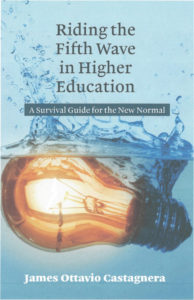Riding the Fifth Wave in Higher Education
Article by: By James Ottavio Castagnera, JD, PhD
 “Fifty percent of the 4,000 colleges and universities in the U.S. will be bankrupt in 10 to 15 years.” So says Harvard Business School Professor Clayton Christensen. 1
“Fifty percent of the 4,000 colleges and universities in the U.S. will be bankrupt in 10 to 15 years.” So says Harvard Business School Professor Clayton Christensen. 1
This is a profoundly disturbing prediction, especially coming as it does from the guru of the “disruption” theory of businesses’ rise and decline. How can it be true? “In his recent book, ‘The Innovative University,’ Christensen and co-author Henry Eyring analyze the future of traditional universities, and conclude that online education will become a more cost-effective way for students to receive an education, effectively undermining the business models of traditional institutions and running them out of business.” 2
A decade and a half before Christensen and Eyring pronounced their prediction, I published an article in which I traced five distinct eras or “waves” in American higher-education history: the era of small liberal arts colleges, starting in the colonies; the establishment of the large land-grant universities, beginning around the Civil War; the rise of the great private R1 institutions, thanks to the largess of the Rockefellers, Carnegies, and Stanfords; the post-WWII age of the megaversity; and, now, the “Fifth Wave,” propelled to our shores by the Internet.
 In my new book, Riding the Fifth Wave in Higher Education: A Survival Guide for the New Normal 3, I argue that the trillion-dollar student-loan bubble, the tuition-discount “death spiral,” and the facilities “arms race” combine with Christensen’s online-education nemesis to create a perfect storm. The vectoring of these forces, I contend, creates an existential threat to small and mid-sized colleges and universities never before seen in American higher education.
In my new book, Riding the Fifth Wave in Higher Education: A Survival Guide for the New Normal 3, I argue that the trillion-dollar student-loan bubble, the tuition-discount “death spiral,” and the facilities “arms race” combine with Christensen’s online-education nemesis to create a perfect storm. The vectoring of these forces, I contend, creates an existential threat to small and mid-sized colleges and universities never before seen in American higher education.
The first half of the book is an extended examination of the “Fifth Wave,” our era of Internet and for-profit competition, diminished home-equity savings, a trillion-dollar student-debt bubble, and a multi-billion-dollar regulatory burden—a perfect storm buffeting traditional public and private universities. The second half is my modest attempt at offering some solutions. I draw from numerous examples across higher education and make bold to pose a few ideas of my own.
Professor Christensen’s dire warning resonated with the recent financial crisis experienced by my home institution, Rider University in central New Jersey. Rider has met the challenge with a three-pronged response: the launching of new academic programs, which have reversed an enrollment/retention decline; successful concession bargaining with its faculty union; the pending sale of an auxiliary campus in Princeton, which will generate investment capital to meet main-campus needs. I have been privileged as the institution’s Associate Provost to play a part in these initiatives.
My personal goals go beyond the publication of my new book. As I stare down the tunnel of what likely will be my last decade of service to academia, I aim at playing my part in preserving, defending and advancing what remains the greatest higher-education system the world has known. American colleges and universities—to paraphrase Thomas Jefferson—are the last, best hope of a planet on which only a tiny fraction of the inhabitants have college degrees. They also are one of only two or three global economic sectors in which the United States remains the world-beater. And, last but hardly least, in this era of fake news and political intolerance, they are to our divided nation what the Irish monasteries were to Western Europe in the Viking age. One could hardly choose a better cause into which to pour one’s energies and abilities today.
1 [http://blog.extensionengine.com/50-of-universities-will-be-bankrupt-in-10-15-years/]
2 [https://news.crendy.com/2017/11/15/harvard-business-school-professor-half-of-american-colleges-will-be-bankrupt-in-10-to-15-years/
3[https://www.amazon.com/Riding-Fifth-Wave-Higher-Education/dp/1433133717/ref=sr_1_1?ie=UTF8&qid=1510408155&sr=8-1&keywords=castagnera+riding+the+fifth+wave]
HIRE AN INTERIM
Searching for an Interim?
Please contact us for more information.

